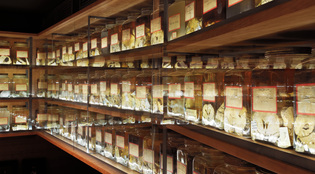 loading
loading
featuresThe brain cutterHarvey Cushing, father of modern neurosurgery, performed his first operation as a Yale undergraduate. (The “patient” was a dog.) He didn’t work at Yale again for 40 years. But in his will, he left Yale the fruits of his labor. Richard Conniff ’73 is the author of, most recently, The Species Seekers: Heroes, Fools, and the Mad Pursuit of Life on Earth.  Christopher GardnerPioneering brain surgeon Harvey Cushing demanded the right to retain all his neurosurgical specimens, leading to the creation of the Cushing Brain Tumor Registry. This meticulous collection of tissues, medical records, sketches, and patient photographs is on display in the newly built Cushing Center at the medical school library. View the panorama or View full imageDeep beneath the stacks of the Yale medical school library, a kind of grotto venerates the human brain. It’s a memorial to an era when surgery on “the closed box” of the human skull was far more mysterious, even macabre, than it seems today. It’s also a celebration of one man who made it less so, essentially inventing modern brain surgery by his odd blend of audacity and painstaking care with scalpel, drill, saw, and clamp. You get a hint of what lies beneath on the stairway down, where a large photograph from 1930 shows a 24-year-old surgical candidate in hospital pajama bottoms, facing the camera and displaying symptoms of the form of gigantism called acromegaly. Surgeon Harvey Cushing, Class of 1891, stands at his side. He is an older and much smaller man, facing the patient, one knee canted forward, one hand in the jacket pocket of a carefully tailored glen-check suit. With his other hand, he holds the giant delicately by two fingers, as if to lead him to his fate. (The patient, a farm laborer, had been told by another doctor that he would “die if anyone operated on his pituitary.” In fact, he was able to write Cushing, three years after surgery, wishing him “high spirits and the best of health.”) Descend one more flight of stairs, and you encounter the twisted skeleton of an acromegaly victim from 1896, before surgical intervention could alter the insidious progress of the disease. It sprawls on its back, chest hugely enlarged, feet deformed, head turned to one side as if to greet the visitor with a howl of dismay. And one level further down, you pass through the key-carded door of the Cushing Center itself, newly opened this summer after a construction and conservation project costing just over $1 million. And then—lights, camera, action—you descend a little farther, along a ramp, past a stage-lit chorus line of brains and tumors suspended in jars of glowing amber-tinted fluid. In places, the brains and photographs of their former owners pose side by side, in mute homage to the work of the difficult, demanding, and often heroic Dr. Cushing.
|
|